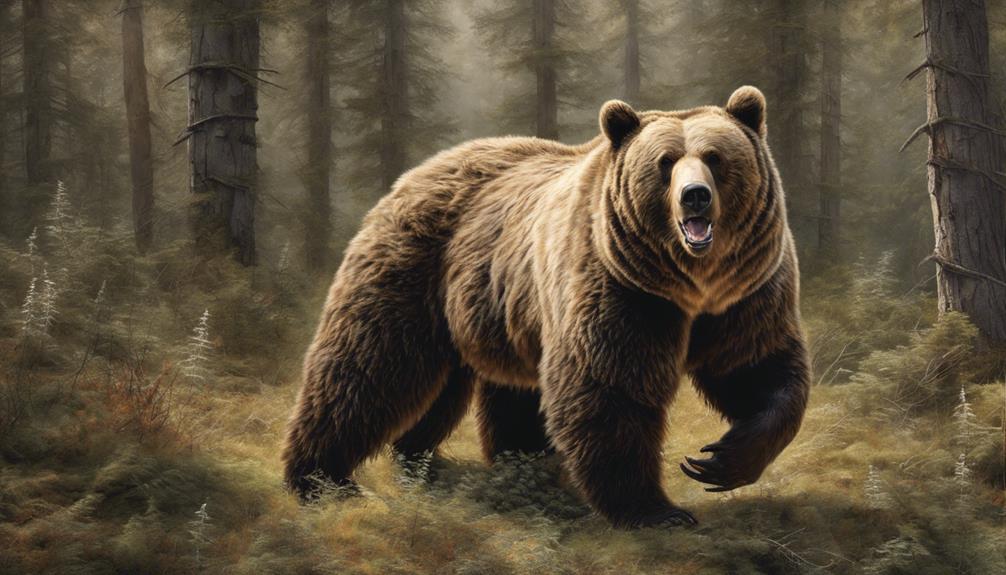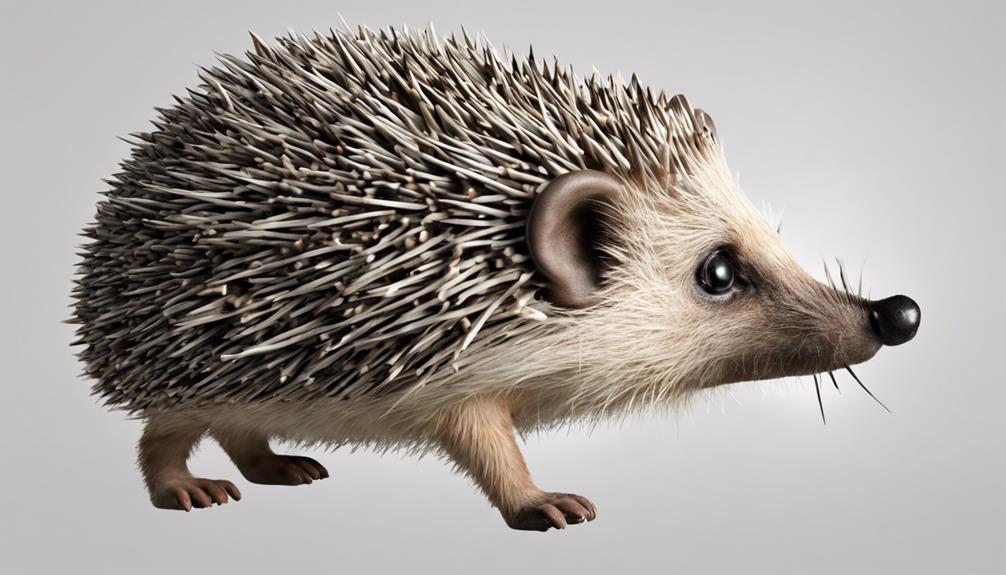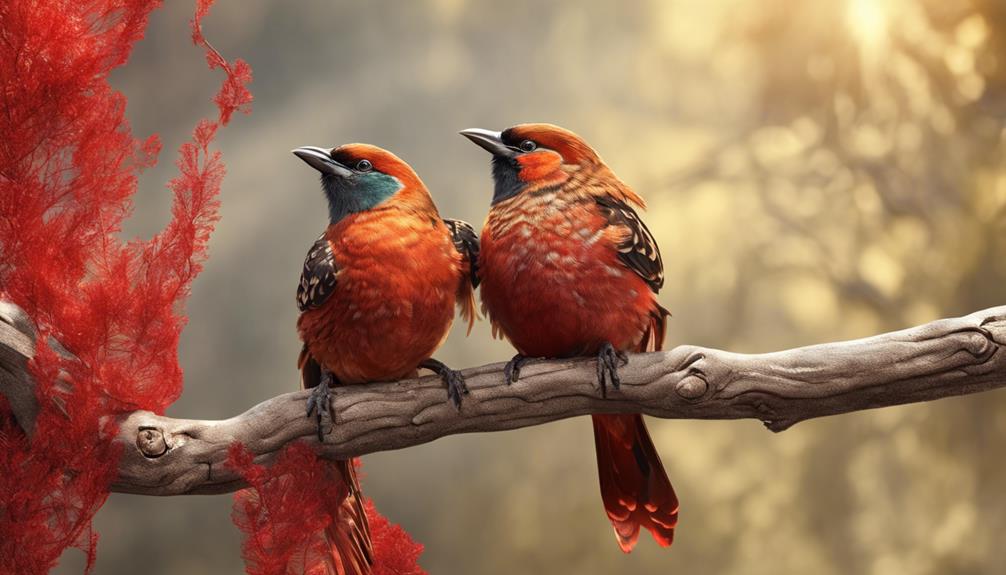Imagine mature bears with bite forces of up to 800 pounds per square inch! Their teeth, 2.5 inches long, help them tear food and defend themselves. Bears can even topple 325-pound boulders effortlessly. Their strength is about five times greater than an average human. Curious about bears' diverse diet? They enjoy plants, berries, insects, fish, and meat, adapting to what's available. You won't believe how skilled they are at climbing, swimming, and detecting scents from miles away. Bears' abilities are truly astounding, showing why they rule their habitats.
Key Takeaways
- Mature bears possess a bite force of up to 800 PSI.
- Their sense of smell is 2,100 times better than humans.
- Bears can reach speeds up to 30 mph.
- They exhibit impressive climbing and swimming abilities.
- Mother bears are protective and teach essential survival skills to their young.
Physical Strength and Abilities
How do mature black bears and grizzly bears showcase their impressive physical strength and abilities in the wild? These bears exhibit astounding power through various remarkable feats. For instance, their bite force can reach up to 800 pounds per square inch (PSI), allowing them to crush bones and tough materials effortlessly. With teeth averaging 2.5 inches in size, mature bears possess formidable tools for tearing into food and defending themselves against potential threats.
Additionally, these mighty creatures can knock over massive 325-pound boulders with just a single paw, demonstrating their immense physical strength. Comparatively, a bear's strength is approximately five times greater than that of an average human, highlighting their dominance in the wild. It's important to understand that bears are capable of delivering a fatal blow to a person with a single swipe, emphasizing their extraordinary strength and agility.
These incredible abilities enable black bears and grizzly bears to navigate their challenging environments with ease and establish themselves as apex predators.
Omnivorous Diet Variety
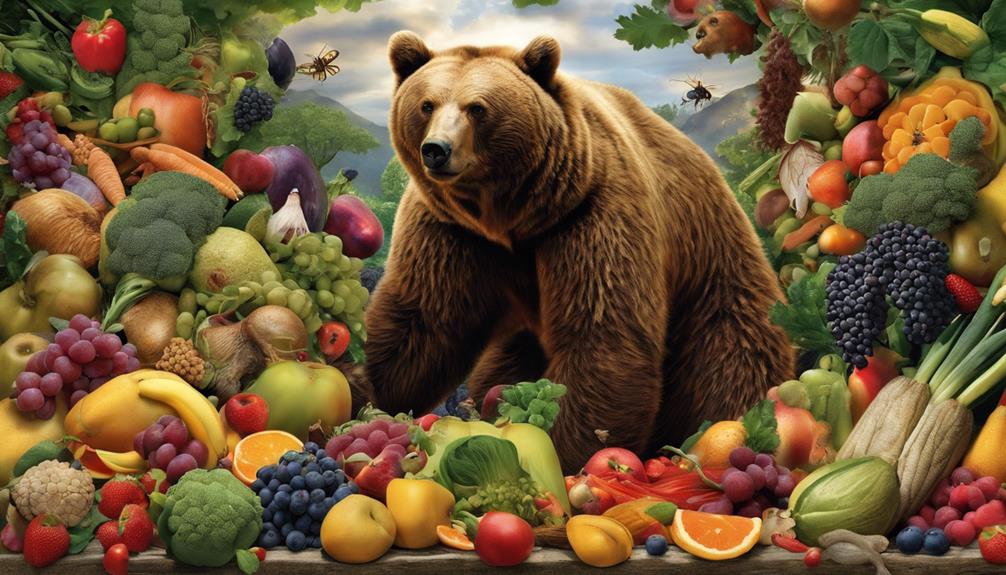
Bears have a diverse diet, eating plants, berries, insects, fish, and meat. Their food choices change with the seasons and what's available, letting them adapt to different environments. By consuming a variety of foods, bears get the nutrients they need to survive and thrive in the wild.
Bears are opportunistic feeders, meaning they will take advantage of whatever food sources are most easily accessible. This flexibility in their diet allows them to be successful in a range of habitats, from forests to coastlines. Additionally, their ability to switch between different food sources helps them endure periods of scarcity.
Diverse Food Choices
When exploring the diverse food choices of mature bears, one can observe their omnivorous diet featuring a variety of plants, berries, fish, and meat. Black bears, known for their scavenging skills, are adept at raiding beehives for honey, complementing their diet with this sweet treat. Below is a table showcasing some of the diverse food choices of mature bears:
| Food Choices | Preferences | Feeding Habits |
|---|---|---|
| Plants | Berries, Fruits | Foraging in forests |
| Fish | Salmon, Trout | Fishing in rivers |
| Meat | Small Mammals, Birds | Hunting in the wild |
Bears exhibit opportunistic feeding behavior, adapting their diet based on habitat and seasonal availability to meet their energy requirements for survival.
Balanced Nutritional Intake
Exploring the omnivorous diet variety of mature bears reveals their ability to maintain a balanced nutritional intake through a diverse range of food sources. Brown bears and black bears are known for their adaptable eating habits, consuming plants, berries, insects, fish, and occasionally meat. This varied diet allows them to adjust to changes in seasons and habitats, ensuring they meet their nutritional needs.
Bears exhibit impressive foraging skills, scavenging for food, raiding beehives for honey, and consuming up to 20,000 calories daily in the fall to prepare for hibernation. By incorporating such a wide array of foods, mature bears obtain essential nutrients and energy for their daily activities and survival during hibernation, showcasing their resilience and adaptability in different environments.
Impressive Climbing Skills

Scaling trees effortlessly, black bears showcase their impressive climbing skills with the aid of their strong claws. Unlike grizzly bears, black bears have shorter claws, which help them climb vertical surfaces with agility and speed. These adaptable creatures can ascend to the treetops to forage for food or find refuge from potential threats.
Their extraordinary climbing abilities not only enable them to navigate their surroundings but also provide them with a strategic advantage in accessing essential resources dispersed throughout their diverse habitats. Even from a young age, black bear cubs demonstrate remarkable climbing aptitude, observing and learning from their mothers as they hone this essential skill.
Skilled Swimming Abilities
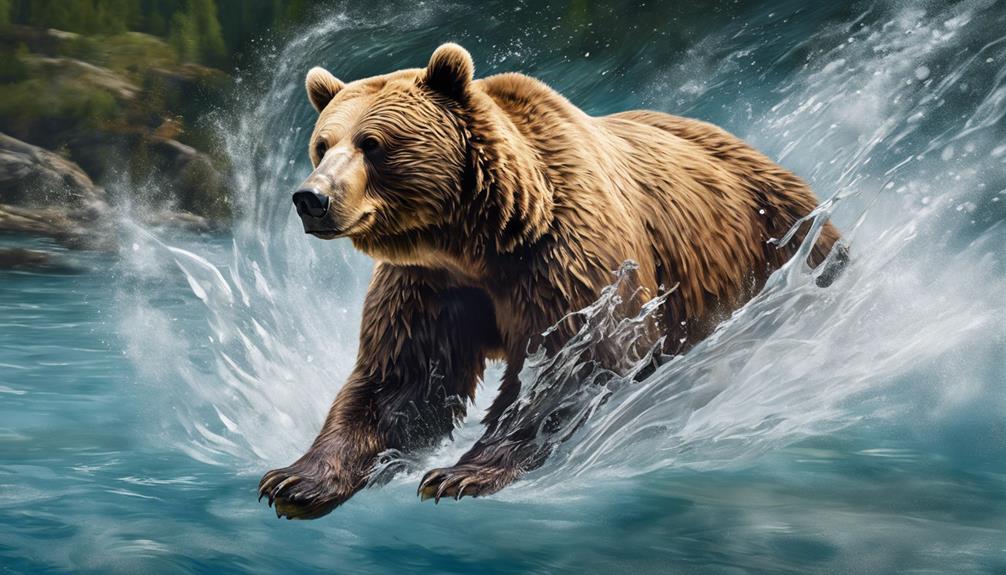
Bears have strong paddling techniques that enable them to navigate through water with ease. Their efficient underwater navigation skills come from their natural water adaptation, allowing them to move swiftly.
This combination of abilities makes swimming a vital skill for bears to explore their surroundings and hunt for food effectively.
Strong Paddling Techniques
With their remarkable swimming skills, mature bears showcase a strong paddling technique that propels them through water with impressive efficiency. Bears utilize all four limbs simultaneously, employing their powerful front paws to propel themselves forward. This synchronized movement allows them to swim long distances, exploring rivers and lakes effortlessly.
The bears' strong paddling techniques are essential for accessing food sources and exploring their habitat. Their ability to swim with agility and speed is a proof of their adaptability in various environments. Observing bears in action, it becomes evident how their adept paddling skills contribute to their survival and success in the wild.
Efficient Underwater Navigation
Effortlessly gliding through underwater domains, mature bears showcase their impressive swimming abilities with efficient navigation techniques. Their streamlined bodies and powerful limbs enable them to move swiftly through water, utilizing their senses of smell to locate prey.
Bears can hold their breath for up to 3 minutes, allowing them to dive deep in search of food sources. Their skilled swimming abilities not only aid in catching fish but also provide access to otherwise inaccessible aquatic environments. By combining agility and speed underwater, bears demonstrate their adaptability in various habitats, making them formidable predators in both land and water.
These remarkable capabilities highlight the remarkable evolution of bears as versatile and proficient swimmers.
Natural Water Adaptation
Naturally adept in water, mature bears showcase their impressive swimming abilities through efficient navigation techniques.
- Bears can swim over a mile in freshwater, demonstrating their prowess in the water.
- Their swimming skills enable them to traverse water bodies effortlessly, aiding in their search for food.
- Cubs are introduced to swimming early on to hone their aquatic capabilities.
Bears utilize swimming not only for transportation but also as a strategic advantage when hunting for fish.
Their natural affinity for water sets them apart as skilled swimmers in the animal kingdom, showcasing their adaptability to various environments.
Remarkable Speed
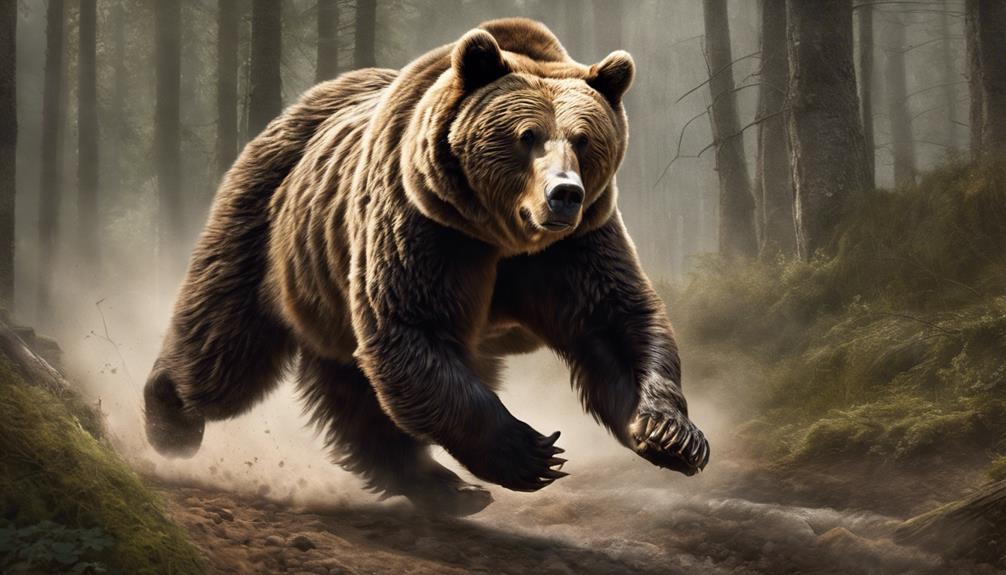
Mature bears demonstrate remarkable speed in short bursts, reaching speeds up to 30 mph with impressive agility. This incredible velocity allows them to chase down prey efficiently or escape from potential threats in their natural habitat. Found in various regions, bears rely on their speed to secure food and protect themselves, particularly during mating season when competition for mates is fierce.
Despite their size and weight, these powerful creatures can quickly accelerate to high speeds due to their robust muscles. Bears are designed for both strength and agility, which, combined with their speed, make them formidable predators within their ecosystems. Their ability to move swiftly and with precision showcases the remarkable adaptations that have evolved over time to guarantee their survival.
In the wild, a bear's speed is a crucial asset, enabling them to navigate their surroundings effectively and maintain their status as top predators.
Intriguing Breeding Habits
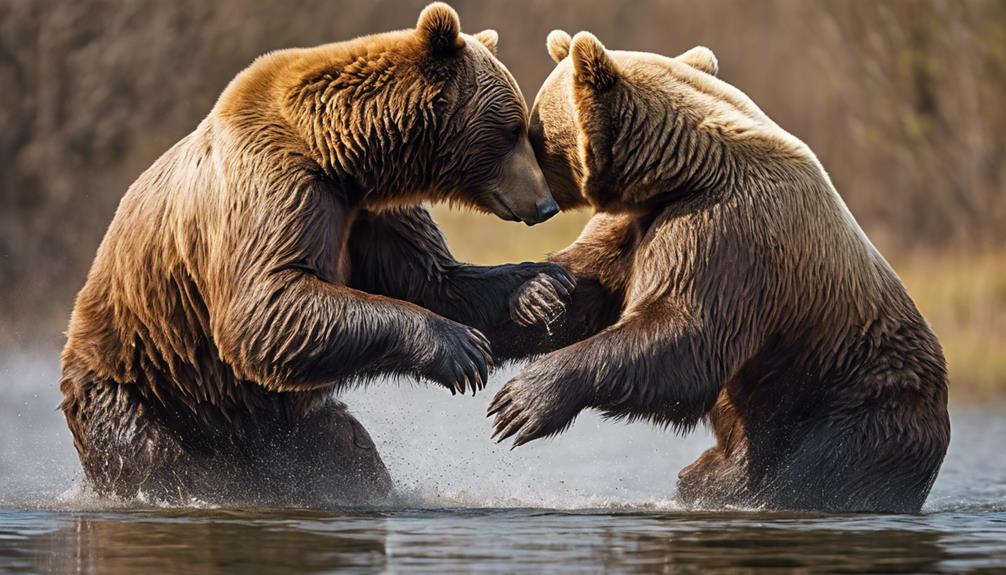
During the summer months, female black bears engage in a unique breeding cycle, typically reproducing every other year. This pattern of reproduction guarantees that the mother bear can adequately care for her cubs and provide them with the necessary support for survival.
Female black bears exhibit a fascinating behavior of delayed implantation, where the fertilized egg doesn't immediately attach to the uterine wall. This allows the mother to time the birth of her cubs to coincide with the most advantageous conditions for their survival.
Black bear mothers are incredibly protective of their young, fiercely defending them against any potential threats. This maternal instinct is essential for the cubs' safety and development.
The bond between a mother black bear and her cubs is strong, with the mother dedicating herself to teaching her offspring essential skills like foraging, climbing, and hunting. This nurturing period is crucial for the cubs' future independence and success in the wild.
Complex Care for Offspring
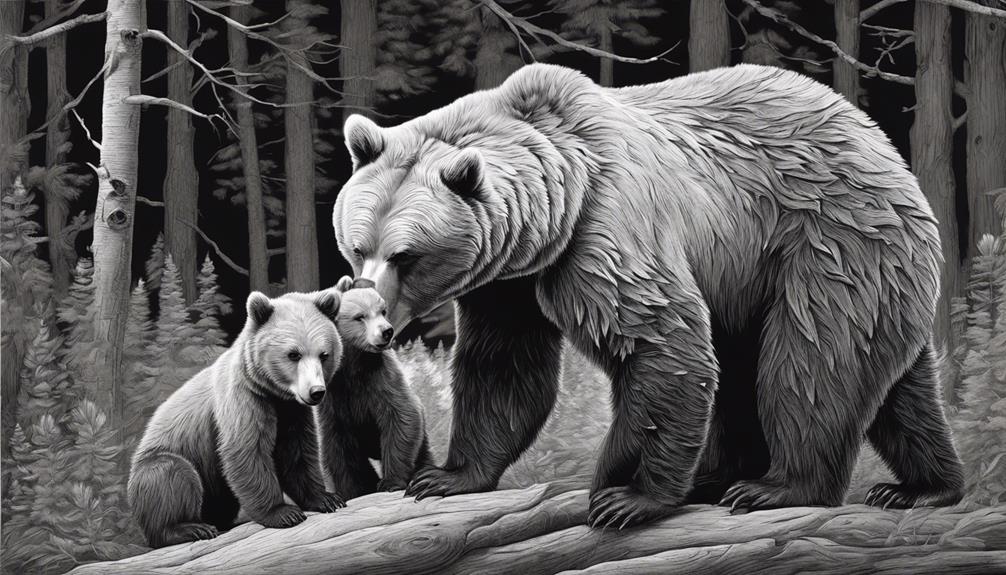
Female bears devote extensive time and effort to nurturing and instructing their offspring in essential survival skills. Cubs learn important behaviors like foraging, hunting, and social interactions from their mothers. This investment in care is vital for the cubs' development and survival in the wild. Mother bears provide protection, food, and guidance to guarantee the well-being of their offspring. The bond between mother bears and their cubs is strong, creating a nurturing and supportive environment for the young bears to thrive.
Bears have a long parental investment period, with cubs staying with their mothers for about 1.5 to 2 years. During this time, the mother bear imparts valuable knowledge that's necessary for the cubs' independence. This includes teaching them how to find food, avoid predators, and interact with other bears. By observing and practicing these skills under the watchful eye of their mother, the cubs grow into self-sufficient individuals prepared for life in the wild.
Powerful Bite Force
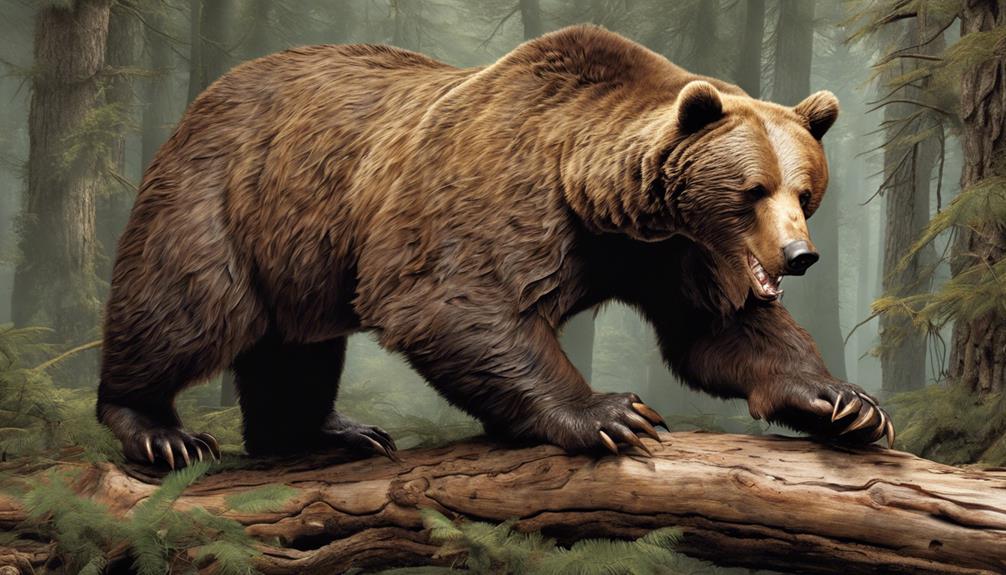
With a bite force of up to 800 pounds per square inch, black bears possess the strength to crush bones and tough materials. Their powerful jaws and teeth are essential for various tasks such as breaking open hard-shelled nuts, digging for insects, and defending themselves from threats. The average tooth size of a black bear is approximately 2.5 inches, aiding in their ability to tear through tough hides and meat.
- Black bears can exert significant pressure with a bite force five times stronger than that of an average human.
- A single swipe from a black bear's paw, combined with their immense strength, has the potential to cause severe harm or even be fatal to a person.
- The strength of a black bear's bite is vital for their survival in the wild, allowing them to consume a wide variety of foods and protect themselves effectively.
Exceptional Sense of Smell
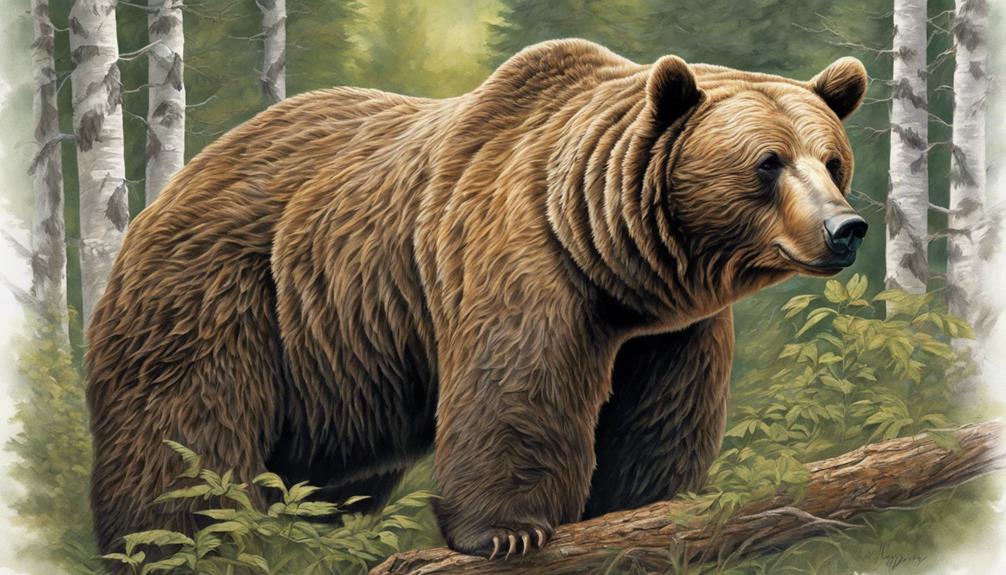
Bears possess an extraordinary olfactory capability, allowing them to detect scents from vast distances. This keen sense of smell is particularly pronounced in species like the brown bear and the American black bear. Imagine having a nose that can pick up scents from miles away – that's the reality for these remarkable creatures. Their sense of smell is estimated to be around 2,100 times better than that of humans, giving them a powerful advantage in the wild.
These bears rely on their exceptional sense of smell for various essential activities. From finding food sources buried under snow to locating potential mates, their olfactory prowess is ideal for survival. Additionally, they can even sniff out danger, helping them avoid potential threats in their environment. Research indicates that under ideal conditions, bears can detect odors up to an impressive 20 miles away. This remarkable ability showcases just how finely tuned their sense of smell truly is, making them formidable predators in their habitats.
Frequently Asked Questions
What Are Some Facts About Adult Bears?
Adult bears are impressive creatures, weighing 300 to 1,200 pounds. They live 20-30 years in the wild, communicate through scent marking, and can be social when needed. In winter, they hibernate to adapt to the environment.
How Fast Do Bears Mature?
I can tell you that bears mature at various rates, influenced by factors like species and environment. Generally, black bears mature around 3-5 years old. Factors such as food availability and social interactions also play a role.
What Are 5 Interesting Facts About Grizzly Bears?
Grizzly bears amaze with their size, fishing skills, keen sense of smell, and habitat in North America. They can weigh between 300-1,500 pounds, adapting to age, sex, and season. These bears are truly remarkable.
What Are 3 Fun Facts About Black Bears?
I'll share three fun facts about black bears. They are skilled climbers, with a keen sense of smell for finding food. These opportunistic feeders can run fast, swim well, and care for their cubs for over a year.
Are there any similarities between mature bears and squirrel-like animals in terms of their behavior or characteristics?
Mature bears and small squirrellike animal facts reveal some similarities in behavior and characteristics. Both are known to hibernate during winter months, forage for food, and exhibit protective behaviors toward their offspring. Additionally, they both demonstrate agility and cunning when acquiring food in their natural habitats.
Conclusion
To sum up, mature bears are truly remarkable creatures. Their physical strength, omnivorous diet, climbing and swimming abilities, speed, breeding habits, care for offspring, bite force, and sense of smell all contribute to their impressive survival skills in the wild.
Like a well-oiled machine, bears are able to adapt and thrive in various environments, showcasing their resilience and adaptability.
It's fascinating to learn about the diverse capabilities and behaviors of these majestic animals.
